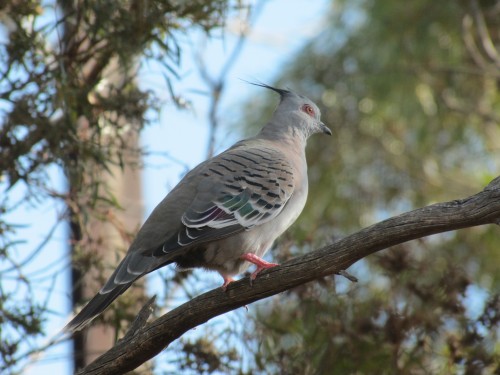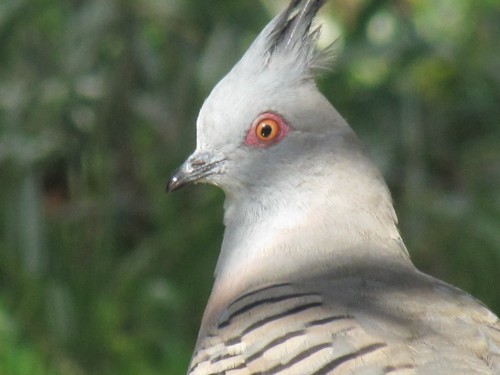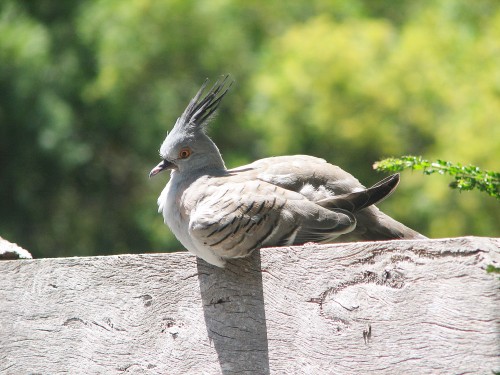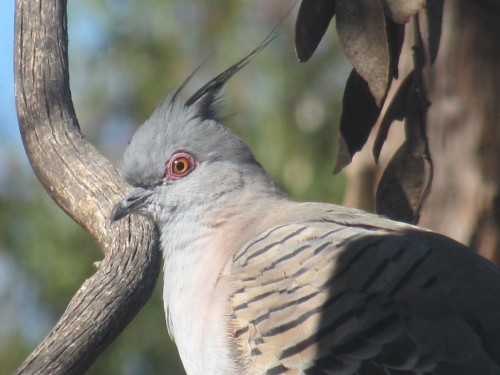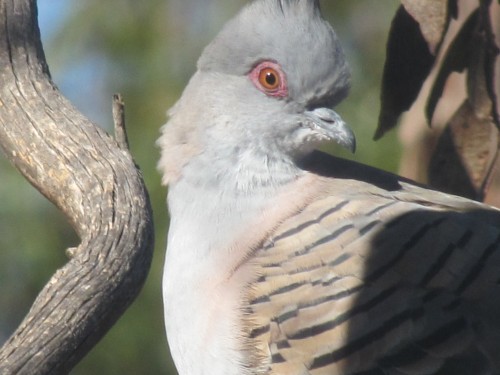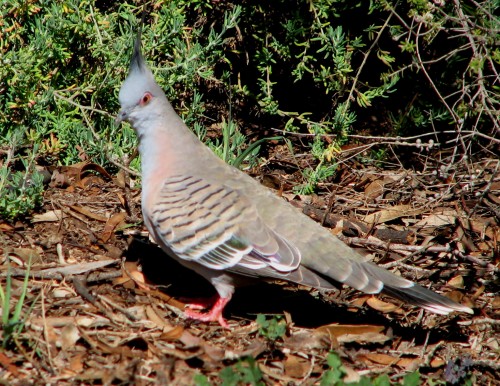Curry the Currawong
Every now and then a reader makes a comment or sends me an email with an amazing or amusing story about a relationship with a bird. Today Cath from the Adelaide Hills sent me the following story about her pet currawong.
Hello there,
I have a currawong here with me at Littlehampton in the Adelaide Hills. Curry came to me via a circuitous route – he was stuck upside down for some hours high in a tree in Crafers last September, rescued by a neighbour of a workmate and finally came to me as they didn’t know what to do. I had never raised a currawong before and I can say it has been a very rewarding experience. I adore the bird.
The bird hadn’t fledged, only had downy feathers and could not stand for about a week. This is back in September. It was just a huge beak surrounded by down.
Plenty of boiled egg, meal worms (with heads squashed), strawberries, blueberres and mulberries. Shards of apple each day. Small lump of cheese for calcium. And mice and rats. At least now Curry is big (voice has broken, eyes now yellow instead of gray-brown) I don’t have to scissor the rodents into pieces for him. He eats them whole. Fresh corn kernels are a favourite. Bits of steak rolled in Wombaroo insectivor mix, too. As a baby I fed him every two hours, now it’s 3 or 4 times a day.
The bird rides on my dog’s back, he just loves the dog. This happened by accident really as once the bird fledged he spent a couple of months free ranging in a big room in my house for part of the day and overnight – outside for most of each day in a big cage for sun and to acclimatise to sounds of the wild. The dog would go into the room and sleep on the couch. So I guess the bird knew very early the dog was no threat. They nestle up to each other and Curry pulls out dog fur and swallows it to use for digestion. They chuck up casts like owls do.
Curry presents me with the wiper blades of my car, steals my lighter, lies on its back at my feet, peeping and squeaking like a chicken, flies onto my shoulder, sits inside the ute on the dashboard if I leave the window down (beware leaving bills and paperwork on dash, they get stolen or shredded).
The bird has teamed up with a magpie of last spring so they are the same age. The magpie comes when I call “Curry chicken” at the top of my voice. They eat together but Curry is jealous and chases the magpie away eventually. He won’t let me carry around my galah, which I have had 4 years and has only 1 wing. Curry flies up and grabs the galah’s tail while she is perched on my shoulder, all the while screaming.
Curry also loves teasing the bantam chooks and has them completely bluffed. All in all, an amazing character and part of my extended animal-only family.
So what to do now? I am moving back east to NSW, to a farm in the middle of the state, and plan on taking the bird with me. It has been in the ute plenty of times and has travelled to the vet’s twice in a small cage and was not worried with his doggy mate sitting right there next to him.
This is how I plan to undertake the big trip east. I feel he will die here as he does not know he is a currawong. Although he responds to the calls of the odd currawong that passes through, I have caught him chasing another juvenile, and hiding from older birds.
The magpies, and there are dozens here, have accepted him finally and he and his magpie mate fly around together and play chasies a lot. But 3 or 4 times a day he wants food from me. He finds his own slaters and earwigs, I know that, and uses his beaks to fish out bugs in the trees overhanging the house. The only neighbours have cats and I fear he would hang around them if I left him here alone.
I’d like to know what you think. Should I transport the birds in the day or overnight? The trip will be a nightmare with the dog, bantams, galah and cockatiel all in the car too. They all know each other though, although I reckon Curry sees the cockatiel as lunch.
Since the bird came from Crafers, I guess he is a grey currawong? Are there any pied currawongs here in SA? It’s bit hard to tell from the photos on the web but he looks like the bird at the top of this site. He has a definite white patch under the tail, white tail tips and white wing tips on the longest wing feathers.
Regards,
Cath
That is an amazing story Cath. Thanks for sharing this with my readers.
You are correct in thinking it is a Grey Currawong. The Pied Currawong is only found in the extreme SE of South Australia. Animals can be quite resilient and I’m sure they will all cope with the journey. I’d be inclined to travel in the cooler hours of the day unless you have reliable airconditioning in your vehicle. All the best with the trip.
Depending on where you are going to live in NSW, you may be in an area that has both Pied and Grey Currawongs.
Crested Pigeons as pet birds
I recently had a rather interesting comment on an earlier post of mine about Crested Pigeons (see Great Birding Moments #5 Crested Pigeons).
Karen wrote:
I have a crested pigeon sitting on my shoulder at the moment. I went for a walk one morning and saw her on the footpath. She ran towards me, not usual pigeon behaviour. I picked her up, she cooed and closed her eyes. I took her home and fed her and she has stayed. She follows me around the house and is the most inquisitive bird I have ever known. She is quite content to be scratched around the head and calls to me whenever I enter the room. She was obviously someone’s pet but I had no success in locating them. I originally had intended to feed her up and let her go again but she is so tame she would have been a danger to herself. She lives with my 3 cockatiels and probably thinks that she is one.
What an amazing experience! Karen is certainly right in deducing that it is someone’s pet, because the behaviour is certainly consistent with a bird that has been used to being handled.
Crested Pigeons are reasonably common in aviculture, especially in zoo collections. This species normally requires a large planted aviary and will breed readily in captivity.
I find it interesting that it is quite at ease in her home and with the Cockatiels. It must make her day very pleasant to have such a lovely team of bird friends to keep her company.
She is probably right that it is safer in her home rather than fending for itself in the wild. If released, it would probably be taken by a hawk very quickly as it would not be as alert to the dangers presented by living life in the wild.
Please note: the laws about keeping native Australian birds in captivity varies from state to state. Please check with the relevant authorities before adopting birds. Your state National Parks and Wildlife website is a good place to start. You local pet shop should also be able to help.
Update: This article was edited and updated in July 2015. The photos below were also added.



